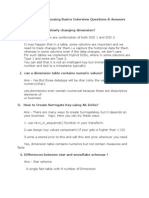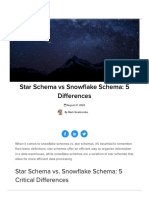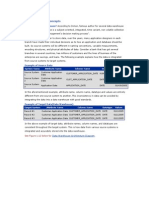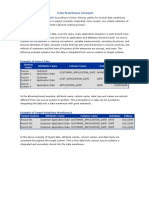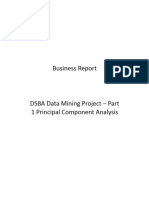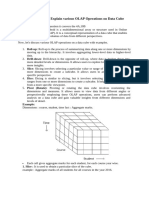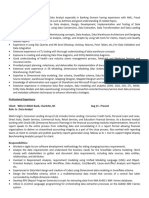DWH-BI Engineer - Assessment Questionaire
DWH-BI Engineer - Assessment Questionaire
Uploaded by
Сашко МицовCopyright:
Available Formats
DWH-BI Engineer - Assessment Questionaire
DWH-BI Engineer - Assessment Questionaire
Uploaded by
Сашко МицовOriginal Description:
Original Title
Copyright
Available Formats
Share this document
Did you find this document useful?
Is this content inappropriate?
Copyright:
Available Formats
DWH-BI Engineer - Assessment Questionaire
DWH-BI Engineer - Assessment Questionaire
Uploaded by
Сашко МицовCopyright:
Available Formats
DWH-BI Engineer - Assessment Questionaire
Interview questions
1. Please describe Facts vs Dimensions with simple example.
2. What are different types of dimensions? Don't count them all from wikipedia, top
three to five types is enough with short description for each.
3. Please describe Star vs Snowflake schema.
4. What is ETL acronym in context of DWH? Please explain.
5. What strategy would you choose for late arriving dimensions? Could you explain your
strategy on a simple yet descriptive example?
Answers:
1. Please describe Facts vs Dimensions with simple example.
Fact table is a primary table in a dimensional model. Fact Table contains
Measurements/facts
Foreign key to dimension table
Dimension table contains dimensions of a fact. They are joined to fact table via a foreign
key. Dimension tables are de-normalized tables.
The Dimension Attributes are the various columns in a dimension table. Dimensions offers
descriptive characteristics of the facts with the help of their attributes. No set limit set for
given for number of dimensions. The dimension can also contain one or more hierarchical
relationships
eiSoftLab d.o.o. | Židovska ulica 8 | 1000 Ljubljana | Slovenia | E: info@eisoftlab.com| W: www.eisoftlab.com
VAT: 40577902 | Registration N.: 8611505000 | Stock Capital: 7.500,00 EUR
Example:
2. What are different types of dimensions? Don't count them all from wikipedia, top three to
five types is enough with short description for each.
Conformed Dimensions:
Conformed dimensions is the very fact to which it relates. This dimension is used in more
than one-star schema or Datamart.
Outrigger Dimensions:
A dimension may have a reference to another dimension table. These secondary dimensions
called outrigger dimensions. This kind of Dimensions should be used carefully.
eiSoftLab d.o.o. | Židovska ulica 8 | 1000 Ljubljana | Slovenia | E: info@eisoftlab.com| W: www.eisoftlab.com
VAT: 40577902 | Registration N.: 8611505000 | Stock Capital: 7.500,00 EUR
Shrunken Rollup Dimensions:
Shrunken Rollup dimensions are a subdivision of rows and columns of a base dimension.
These kinds of dimensions are useful for developing aggregated fact tables.
3. Please describe Star vs Snowflake schema.
Star Schema:
In data warehouse, in which the center of the star can have one fact table and a number of
associated dimension tables. It is known as star schema as its structure resembles a star.
The Star Schema data model is the simplest type of Data Warehouse schema. It is also
known as Star Join Schema and is optimized for querying large data sets.
In the following Star Schema example, the fact table is at the center which contains keys to
every dimension table like Dealer_ID, Model ID, Date_ID, Product_ID, Branch_ID & other
attributes like Units sold and revenue.
Snowflake Schema:
Snowflake Schema In data warehouse is a logical arrangement of tables in a
multidimensional database such that the ER diagram resembles a snowflake shape. A
Snowflake Schema is an extension of a Star Schema, and it adds additional dimensions. The
dimension tables are normalized which splits data into additional tables.
In the following Snowflake Schema example, Country is further normalized into an individual
table.
eiSoftLab d.o.o. | Židovska ulica 8 | 1000 Ljubljana | Slovenia | E: info@eisoftlab.com| W: www.eisoftlab.com
VAT: 40577902 | Registration N.: 8611505000 | Stock Capital: 7.500,00 EUR
4. What is ETL acronym in context of DWH? Please explain.
ETL is a process in Data Warehousing and it stands for Extract, Transform and Load. It is a
process in which an ETL tool extracts the data from various data source systems, transforms
it in the staging area and then finally, loads it into the Data Warehouse system
5. What strategy would you choose for late arriving dimensions? Could you explain your
strategy on a simple yet descriptive example?
That realy depends on the nature of the data but i will use technic that is called
' Complete the dimension later'
Which means i will still create the dmnession using its natural key and fill descripton
columns with N/A or unknown
Example:
A new employee may be eligible for healthcare insurance coverage beginning with their first
day on the job and be issued a valid insurance card with a valid patient ID. However, the
employer may not provide detailed enrollment information to their healthcare insurance
provider for several weeks; it may take several more weeks before the new employee is
entered into the insurer’s operational systems. Of course, the new employee may require
health care during this time and submit claims using their patient ID. In this case, the
insurer’s data warehouse ETL system will receive claim fact row input with a valid patient ID
that doesn’t have an associated row in the patient dimension – yet.
eiSoftLab d.o.o. | Židovska ulica 8 | 1000 Ljubljana | Slovenia | E: info@eisoftlab.com| W: www.eisoftlab.com
VAT: 40577902 | Registration N.: 8611505000 | Stock Capital: 7.500,00 EUR
You might also like
- 42 Excel Interview Questions For Data AnalystDocument7 pages42 Excel Interview Questions For Data Analystxi50% (4)
- Course 02 Module 03 AssignmentDocument7 pagesCourse 02 Module 03 Assignmentrupeshvin25% (4)
- Informatica Interview Part 1Document111 pagesInformatica Interview Part 1Dilip100% (1)
- Qlikview Interview Questions and AnswersDocument12 pagesQlikview Interview Questions and AnswersVijayalakshmi Potturu100% (1)
- Data Warehousing Basics Interview QuestionsDocument24 pagesData Warehousing Basics Interview QuestionsRavikumar DrkNo ratings yet
- Excel Project WordDocument43 pagesExcel Project Worddhruv.jain.dj.8319No ratings yet
- Data Warehouse Concepts: TCS InternalDocument19 pagesData Warehouse Concepts: TCS Internalapi-3716519No ratings yet
- Tableau: Interview GuideDocument24 pagesTableau: Interview GuidePandian NadaarNo ratings yet
- Frequently Asked Interview Questions For Data Analyst RoleDocument12 pagesFrequently Asked Interview Questions For Data Analyst RolePrateek MishraNo ratings yet
- 8 Tableau bq2 7836659Document38 pages8 Tableau bq2 7836659Sudharshan VenkateshNo ratings yet
- Star Schema Vs Snowflake Schema - 5 Differences - XplentyDocument15 pagesStar Schema Vs Snowflake Schema - 5 Differences - XplentyAdrian Ismael RomeroNo ratings yet
- Dimensional ModelingDocument12 pagesDimensional ModelingChetan Mahajan100% (1)
- Dev Answer KeyDocument17 pagesDev Answer Keyjayapriya kce100% (1)
- Capstone Project Final Report Rupesh Kumar PGP-DSBA APR 21CDocument77 pagesCapstone Project Final Report Rupesh Kumar PGP-DSBA APR 21CAnupamaNo ratings yet
- Data Warehousing FAQDocument5 pagesData Warehousing FAQsrk78No ratings yet
- Handout 3Document24 pagesHandout 3Satyanarayana AretiNo ratings yet
- IT Skills Assignment-1Document14 pagesIT Skills Assignment-1gautamdivyanshi26No ratings yet
- Data Warehousing Concepts 2Document26 pagesData Warehousing Concepts 2yprajuNo ratings yet
- Bms Reading MaterialDocument19 pagesBms Reading MaterialRusifar RNo ratings yet
- Data Cubemod2Document21 pagesData Cubemod2sgk100% (1)
- papersolution_insemDocument12 pagespapersolution_insemdarshankhairnar100103No ratings yet
- Devidutta_Predictive_Modeling.pdfDocument25 pagesDevidutta_Predictive_Modeling.pdfAshwiniSapali-KudureNo ratings yet
- Kenny-230718-Top 70 Microsoft Data Science Interview QuestionsDocument17 pagesKenny-230718-Top 70 Microsoft Data Science Interview QuestionsvanjchaoNo ratings yet
- Sta I06 Lecture NoteDocument29 pagesSta I06 Lecture NoteperfectNjaNo ratings yet
- JoinsDocument8 pagesJoinsBharathNo ratings yet
- Learn Excel Pivot TablesDocument188 pagesLearn Excel Pivot TableseBooks DPF Download100% (2)
- SBDM Presentation by Group-ADocument12 pagesSBDM Presentation by Group-ARaj pratap singhNo ratings yet
- Data Warehousing Interview Questions and AnswersDocument5 pagesData Warehousing Interview Questions and Answerssiva_mmNo ratings yet
- DW ConceptsDocument7 pagesDW ConceptsKrishna PrasadNo ratings yet
- DWMDocument19 pagesDWMArnav AmbreNo ratings yet
- Top Excel Interview Questions and Answers To Crack Job InterviewsDocument15 pagesTop Excel Interview Questions and Answers To Crack Job InterviewsNeetirajsinh ChhasatiaNo ratings yet
- Data As Clean of ExcelDocument66 pagesData As Clean of Excelabduo.gah5000No ratings yet
- Dimensional Modeling in Data Warehousing: Bachelor of Technology Computer Science and EngineeringDocument15 pagesDimensional Modeling in Data Warehousing: Bachelor of Technology Computer Science and EngineeringVarsha ModiNo ratings yet
- Dimension Modelling Techniques in Business IntelligenceDocument4 pagesDimension Modelling Techniques in Business IntelligenceInternational Journal of Application or Innovation in Engineering & ManagementNo ratings yet
- Data Warehouse Concepts PDFDocument14 pagesData Warehouse Concepts PDFhot_job_hunt0% (1)
- Shubham SpreadsheetDocument94 pagesShubham SpreadsheetRaman TiwariNo ratings yet
- Company InterviewDocument24 pagesCompany Interviewsabbanwar16No ratings yet
- Basics of Dimensional ModelingDocument14 pagesBasics of Dimensional Modelingrajan peri100% (1)
- Lab 5Document19 pagesLab 5samrayyan786420No ratings yet
- introduction to DataWarehouse and DataMiningDocument35 pagesintroduction to DataWarehouse and DataMiningP.Padmini RaniNo ratings yet
- To Develop Clusters of The Users Using ML For The Customer SegmentationDocument20 pagesTo Develop Clusters of The Users Using ML For The Customer Segmentationgattus123No ratings yet
- ETL Testing - InterviewQuestion PDFDocument21 pagesETL Testing - InterviewQuestion PDFchiranjeev mishraNo ratings yet
- Data MningDocument10 pagesData MningrapinmystyleNo ratings yet
- The Basic of Data Cleaning 1711767651Document64 pagesThe Basic of Data Cleaning 1711767651naveenNo ratings yet
- Data Mining Project DSBA PCA Report FinalDocument21 pagesData Mining Project DSBA PCA Report Finalindraneel120No ratings yet
- Data Understanding and PreprationDocument10 pagesData Understanding and PreprationMohamedYounes100% (1)
- BO Interview QuestionsDocument74 pagesBO Interview QuestionsAtc CheNo ratings yet
- Operational Data Stores Data Warehouse: 8) What Is Ods Vs Datawarehouse?Document15 pagesOperational Data Stores Data Warehouse: 8) What Is Ods Vs Datawarehouse?Narayana Reddy SannapureddyNo ratings yet
- Excel Power BI Interview Questions CA Isha Jaiswal GMUDocument9 pagesExcel Power BI Interview Questions CA Isha Jaiswal GMUDamesha ManoharanNo ratings yet
- Unit 2Document8 pagesUnit 2Binay YadavNo ratings yet
- MS Excel Ms Powerpoint NotesDocument31 pagesMS Excel Ms Powerpoint NotesKamal MittalNo ratings yet
- Classic Star Schema As Data Model of Data WarehouseDocument7 pagesClassic Star Schema As Data Model of Data WarehouseAnanya BiswasNo ratings yet
- Basic Data CleaningDocument64 pagesBasic Data CleaningData With Sandeep100% (1)
- Entity-Relationship Model: Data Warehouse Data ModelsDocument4 pagesEntity-Relationship Model: Data Warehouse Data ModelsMahima PrasadNo ratings yet
- EDADocument9 pagesEDAgblespaulguitarist100% (1)
- ETL Testing FundamentalsDocument5 pagesETL Testing FundamentalsPriya DharshiniNo ratings yet
- DW-DM R19 Unit-1Document25 pagesDW-DM R19 Unit-1PRIYANKA GUPTA100% (1)
- DWM Lab ManualDocument17 pagesDWM Lab ManualPranav KhamitkaRNo ratings yet
- Advanced Analytics with Transact-SQL: Exploring Hidden Patterns and Rules in Your DataFrom EverandAdvanced Analytics with Transact-SQL: Exploring Hidden Patterns and Rules in Your DataNo ratings yet
- Microsoft Excel Statistical and Advanced Functions for Decision MakingFrom EverandMicrosoft Excel Statistical and Advanced Functions for Decision MakingNo ratings yet
- Schemas For Multidimensional DatabasesDocument5 pagesSchemas For Multidimensional DatabasesddhakalNo ratings yet
- Data ModelingDocument3 pagesData Modelinggoodstart1245No ratings yet
- Unit-2 DMDWDocument33 pagesUnit-2 DMDWclassysniper99No ratings yet
- Applied DAX With Power BI - Teo Lachev - 2019Document367 pagesApplied DAX With Power BI - Teo Lachev - 2019Ned Thai100% (1)
- Da Bank Ibm 400 GCPDocument3 pagesDa Bank Ibm 400 GCPbidyutNo ratings yet
- Designing The Star Schema DatabaseDocument12 pagesDesigning The Star Schema DatabaseranganadhkodaliNo ratings yet
- Qlikview Architecture: It Conatains Developer, Publisher, ServerDocument23 pagesQlikview Architecture: It Conatains Developer, Publisher, ServerVenkatesh VenkiNo ratings yet
- DP-900 Microsoft Azure Data Fundamentals (Beta) 112QDocument78 pagesDP-900 Microsoft Azure Data Fundamentals (Beta) 112QhyoitoNo ratings yet
- Define Data Warehouse. Differentiate Between OLTP and OLAP DatabasesDocument6 pagesDefine Data Warehouse. Differentiate Between OLTP and OLAP DatabasespreethamkrishnaNo ratings yet
- Data Warehouse SchemasDocument87 pagesData Warehouse Schemassnivas1No ratings yet
- Data Warehousing Schemas and ObjectsDocument24 pagesData Warehousing Schemas and ObjectsUmt BbisNo ratings yet
- Star and Snowflake Schema in Data Warehouse With Model ExamplesDocument4 pagesStar and Snowflake Schema in Data Warehouse With Model ExamplesRanztyn TortorNo ratings yet
- Snowflake SchemaDocument4 pagesSnowflake SchemaSreenath VadigepalliNo ratings yet
- Assignment No. 1: Lab Practices-2 Fourth Year Computer Engineering EngineeringDocument16 pagesAssignment No. 1: Lab Practices-2 Fourth Year Computer Engineering EngineeringDhiraj PatilNo ratings yet
- Data Model SchemasDocument5 pagesData Model Schemasdeysoham16No ratings yet
- Name: Reena Kale Te Comps Roll No: 23 DWM Experiment No: 1 Title: Designing A Data Warehouse Schema For A Case Study and PerformingDocument7 pagesName: Reena Kale Te Comps Roll No: 23 DWM Experiment No: 1 Title: Designing A Data Warehouse Schema For A Case Study and PerformingReena KaleNo ratings yet
- Amey B-50 DWM Lab Experiment-1Document12 pagesAmey B-50 DWM Lab Experiment-1vu1f2122109No ratings yet
- Assignment 4-1Document27 pagesAssignment 4-1samina khanNo ratings yet
- Case Study On Building Data Warehouse/Data MartDocument6 pagesCase Study On Building Data Warehouse/Data MartCandida Noronha100% (2)
- Dimensional ModelingDocument22 pagesDimensional ModelingajazkhankNo ratings yet
- MVA Implementing A Data Warehouse With SQL Jump Start Mod 1 FinalDocument37 pagesMVA Implementing A Data Warehouse With SQL Jump Start Mod 1 FinalKeerthan ManjunathNo ratings yet
- Data Mining N Business IntelligenceDocument63 pagesData Mining N Business IntelligenceVishal AnandNo ratings yet
- DWDM Unit-2Document79 pagesDWDM Unit-2DhirenNo ratings yet
- Data Warehousing SS G515 Me Software Systems BITS Pilani, Dubai CampusDocument46 pagesData Warehousing SS G515 Me Software Systems BITS Pilani, Dubai CampusTamizharasan P SNo ratings yet
- Snowflake & StarflakeDocument9 pagesSnowflake & Starflakead_b4u100% (2)
- SAP HANA DefinitionsDocument158 pagesSAP HANA DefinitionssridharNo ratings yet
- Experiment2 E059 DWM PDFDocument10 pagesExperiment2 E059 DWM PDFVikas SharmaNo ratings yet




